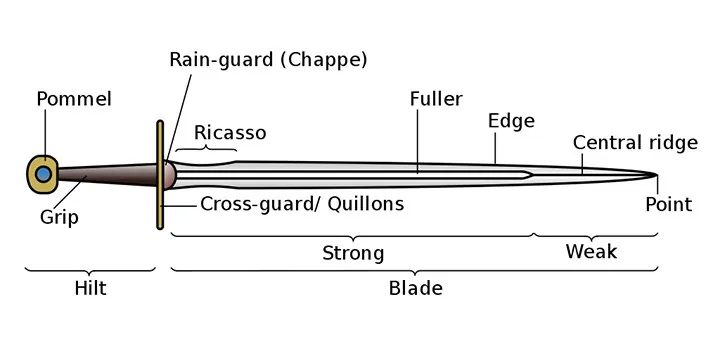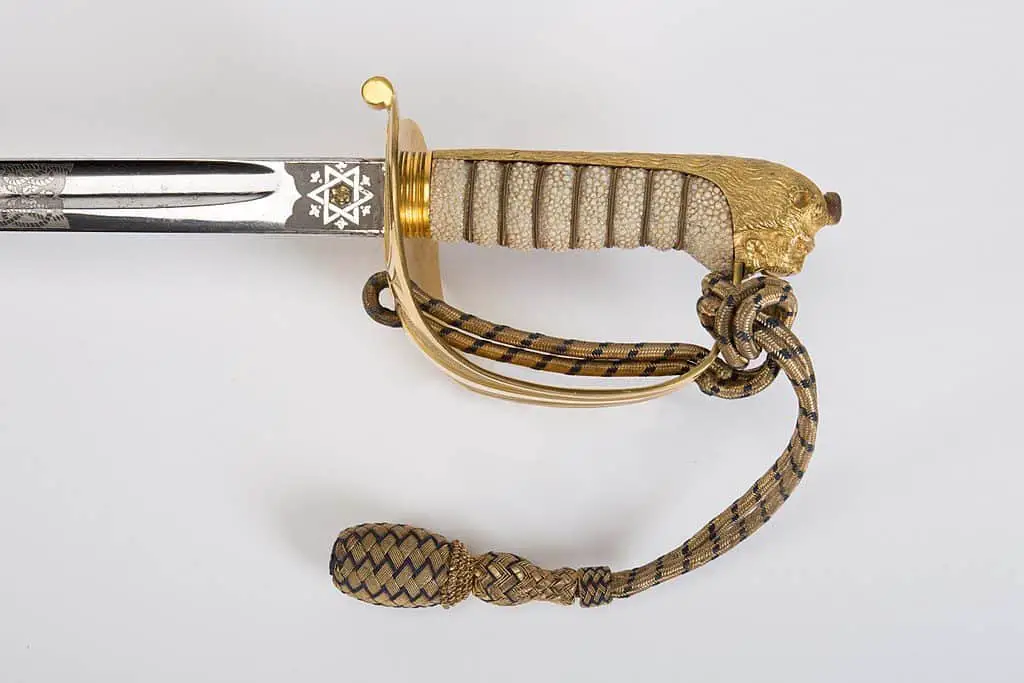Have you ever talked with an expert about swords? Most of these guys tend to use really fancy words for sword parts and components. Therefore, you might not completely understand what they are talking about. I have been in this situation many times before and it took me quite a while to get the hang of the sword terminology.
In this article, I will give you an overview of everything you need to know about the different parts.
Table of Contents
Main Sword Parts
There are four main components of a sword.

Blade – Steel component of a sword which is used for cutting and thrusting.
Cross-guard – Metal bar at right angles to the blade. Protects the wielder’s hands.
Grip – The handle of the sword. Created from wood or metal.
Pommel – Counter-weight at the end of the sword.
Sword Components: In-Depth
In this chapter, I will give you more advanced information about this topic.
To keep it simple I told you that a sword consists of four parts. That is not completely correct if we look at this from a more detailed perspective. The regular medieval sword actually only consists of two different parts. That is the blade and the hilt.
In the next section, you will find more information on these two categories.
Blade
There are a lot of different blade parts we need to cover. I’ll do my best to provide you with the best answer possible. So come with me.
Sections
The entire blade is categorised in two different segments. Namely the forte and the debole.
The forte is the strong part of the blade. This is considered to be the two-third closest to the hilt. Because of its high toughness, the forte is mostly used for parrying and blocking opponents’ attacks.
On the other hand, the debole is the weaker part of the blade. This piece is mainly used for offensive actions.
Point
The point is the tip of the sword blade. Depending on the primary purpose of the sword, the sharpness of the point can vary. For instance, a sword used for thrusting needs to be sharply pointed in order to penetrate armour.
Whereas the point is very important for thrusting weapons the edge serves the swords cutting ability.

Edge
The edge is the part of the sword used for cutting. Swords are either single or double-edged.
On a single-edged sword, only one edge is sharpened. The other one is blunt.
Whereas on a double-edged sword both of the edged can be used for cutting.
Fuller
The fuller is the groove down the centre of the blade. It used to lighten the blade, thus making it easier to wield. Furthermore, this process saves a lot of steel, since you can forge a wider blade with less steel.
The fuller is oftentimes incorrectly called blood groove. As just explained the fuller has nothing to do with blood.
Ricasso
The ricasso or shoulder is the unsharpened portion of blade between the cross-guard and the edge. Typically used on heavier swords it allows the wielder to place their index finger or whole hand above the cross-guard.
It is important to note that most swords do not have a ricasso.
Hilt
The handle of a sword consists of four main segments. Three of them were already mentioned in my overview of this topic.
So, come with me as we explore these parts of a medieval sword.
Cross-guard
This is the metal bar protecting the hand of the wielder from the opponent’s sword. It provides protection against an enemy sword sliding down the edge of the blade towards the hilt.
The cross-guard is in place to block swords right before they can reach the hand of the defender.
With the abandonment of armoured gauntlets and shields, this sword component needed to be modified. Therefore, the basket-hilt was invented. It provided protection for the entire hand of the swordsman.

Grip
There isn’t much to say about the grip of a sword. The grip refers to the handle of the sword. Typically, it is created from wood or metal and most of the time covered with untanned tough leather or sharkskin. On the contrary Japanese swords used ray skin instead.
Pommel
The pommel is the mounting at the end of the hilt. It mainly serves two purposes. Whilst they are used as a counter-weight, they also prevent the hand slipping from the grip.
Chappe
The chappe is the last important part of a sword. The chappe was attached to the sword’s cross-guard. It protects the mouth of the scabbard and prevents water from entering. Therefore, it is also called rain guard.
The chappe was developed and commonly used in the late medieval era.
Conclusion
I hope that I could provide you with everything you wanted to know about the various sword components and parts. Most of the parts used for a sword depend on the purpose of the weapon. The famous historian Ewart Oakeshott created a classification system for swords. The different Oakeshott types feature various combinations of those components. In case you are interested you can check it out here.